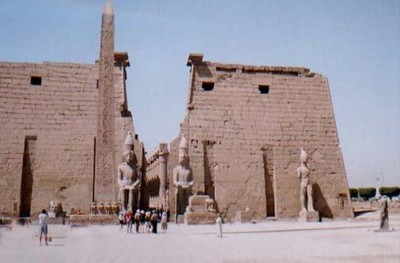Temple of Luxor
A strip of green in the middle of the desert tilled fields and in the background the red rocks of the “Libyan Chain” Here lies Luxor, one of the
greatest capitals of the ancient world.
Charming and evocative, with the Nile along the quiet waters of the river, the small, silent streets of the Bazaar that come to life in the evening with their colours, sounds and lights
This is the great, ancient city of Thebes, capital of the Egyptian empire for almost one thousand years, which Homer referred to in the IX canto of the Iliad as “Thebes with one hundred gates” and for which “only the grains of sand in the desert surpassed the abundance of wealth contained therein”.
The Copts called it Tapé, hence the Greek Thebai, but for Egyptian inhabitants it was Uaset, meaning “the chief town” and Niut, “the City” it was later on called Diospolis Magna. Its present name of Luxor comes from the Arab El Qousour, translation of the Latin “Castra” with which the ancient Romans indicated the city where they had installed two encampments.
In the Memphis era it was a small village where the God of War Montu was worshipped and its temples marked the boundaries of the territory.
As from the X Dynasty, thanks to its geographical position and political grounds, its importance started to increase considerably until the military successes of its princes made it a great power.
Capital of the pharaohs of the New Empire, the god Amon was worshipped in great splendour in the triad in Mut and Khnsu. It was the age of great victories and triumph in Asia Minor, Nubia and Libya.
It was a happy period – perhaps the happiest in Egyptian history – and Thebes had no rivals : victorious Pharaohs accumulated incredible wealth there (city where the houses are rich in treasure) from war booty; from the Red Sea the Persian Gulf and even from the Sahara – across the road of the oases – merchants arrived to grow rich and to enrich the townsmen of Thebes who reached the incredible figure of half a million!
One the east bank rise the temples in which the gods dwelt whereas on the west bank building were constructed for the worship of dead sovereigns; apart from this theory of temples, parallel to the river runs the heavy rock curtain that conceals the Valley of the Kings.
Thebes then inexorably fell. The very geographical position that one thousand years beforehand had favored the birth of its power now became the main reason for its decline : too far from the “hot” delta region, where the Ramses were forced to create military stations to stem foreign invasions, Thebes lost its political, spiritual and military supermacy.
Subsequent dynasties originally came from the delta and the twons of tains, Bubast and Sais replaced it as capital of Egypt. Left defenseless.
Thebes fell prey to the Assyrian army lead by Assarhaddon, which sacked it in 672 B.C.; once again in 665, Assurbanipal’s army deported the townsmen before turning them into slaves and stripped the town of its statues and treasures.
Lastly, it was completely razed to the ground in 84 B.C. by Ptolemy Lathyros to the extent that during the roman era it was a mass of ruins visited by wayfarers; the few remaining townsmen settled in what remained of the temples and the tombs were reduced to stables. This time too, as happened in the case of Memphis, Ezekiel’s prophecy that Thebes would be violently shaken came true
for a lot of infformation click to



ساحة النقاش